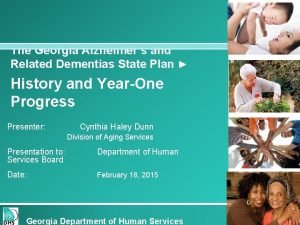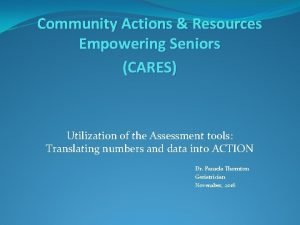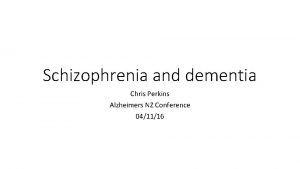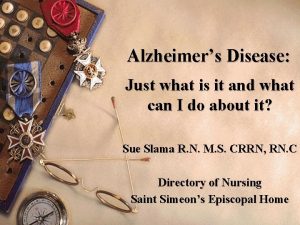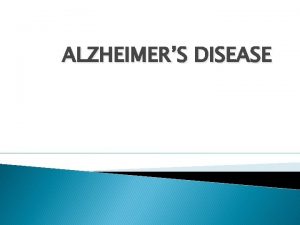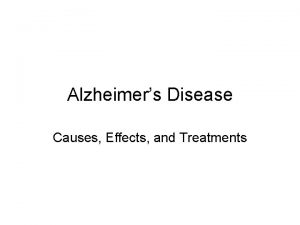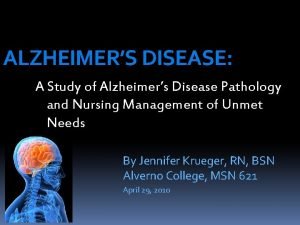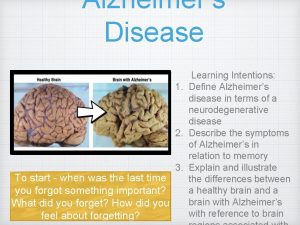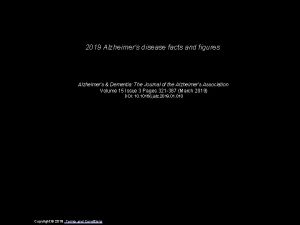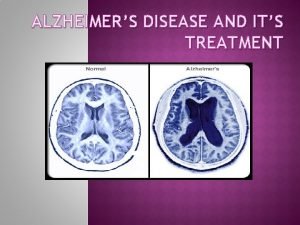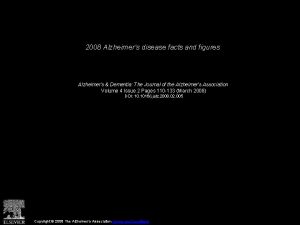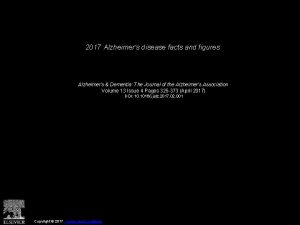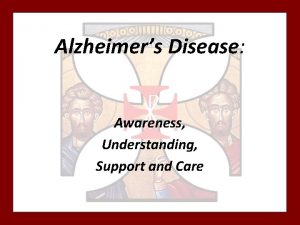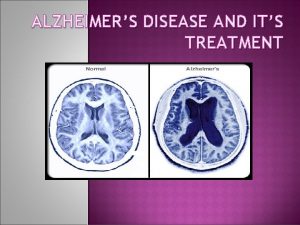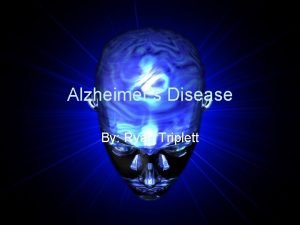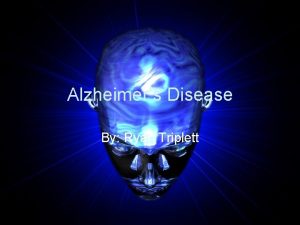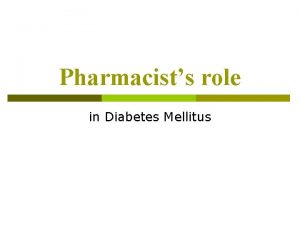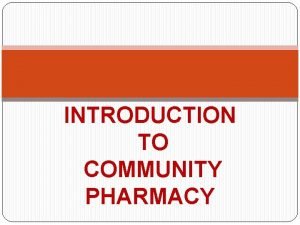Community Pharmacists and Alzheimers Disease Knowledge and Practice


















- Slides: 18

Community Pharmacists and Alzheimer’s Disease: Knowledge and Practice Hamzah Al Zubaidi, Ph. D.

Contents • Introduction • Aims and objectives • Methods • Results • Discussion • Conclusion

Background • Alzheimer’s disease (AD) is a neurodegenerative disorder characterized by progressive memory impairment, cognitive and executive function deficits, and behavioral and psychiatric disturbances. It is the most common form of dementia. • AD is not a normal part of the aging process, but its prevalence increases with age. • Worldwide, the prevalence of AD and dementia is projected to increase. This will be associated with increased societal and economic burden. • Since 2010, the annual societal and economic costs of AD increased by 65%, reaching USD 1 trillion in 2018. • As AD progresses, patients become increasingly debilitated and require intensive and continuous help from family members and caregivers to perform daily activities. • Such as eating, changing, bathing, taking medicines, managing aggressive or depressive behaviour, and incontinence. • The burden on family members and caregivers significantly decreases their quality of life.

Background- 2 • The proportion of elderly people is increasing in many Middle-Eastern countries. • Prevalence of dementia in people over 60 years in MENA region is higher than the global average and is set to increase by 125% by 2050. • It is predicted that the early onset of CVDs and stroke in Arabic-speaking populations may lead to earlier onset of AD. • In Middle-Eastern culture, there is a sense of duty to care for elder members of the family by family members. • In comparison with Western countries, more people with AD in Arabicspeaking societies reside with their younger kin, who are usually responsible for providing care and support to them.

Background- 3 • AD is mainly treated with medications. • Two classes of medications are approved: • Cholinesterase inhibitors: donepezil, galantamine, and rivastigmine • NMDA receptor antagonist: memantine • No available medications reverse or slow down the progress of AD. Medications produce significant reduction in disease severity scores, but often not to a clinically significant level. • The vast majority of patients with AD are over 65 years of age and are likely to also have other diseases like CVDs and diabetes. • Polypharmacy is common and can increase the risk of adverse drug reactions, interactions, and poor adherence. • Poor adherence is associated with low quality of life, poor health outcomes, and increased hospitalisations.

Background- 4 • Community pharmacists are well-positioned to provide care for patients with AD and advise their caregivers. • Pharmacists are drug experts and can: • provide medication review services to identify and resolve drug-related problems • educate patients and caregivers about the safe and appropriate use of medications • simplify treatment regimens, offer adherence aids, and improve patients’ quality of life • Pharmacists are frequently in contact older patients who are at increased risk for AD. They may be able to screen patients for AD, educate them, and refer them to physicians for further evaluation. • The informal system of care by family members and friends needs a high level of support at the policy and societal levels. • Community pharmacists can be an important source of support. • Assessing the current competence of community pharmacists and service provision in the care for patients with AD is necessary to identify knowledge and skill gaps, and develop training programs that equip pharmacists with the tools needed to provide optimal care.

Aims and Objectives • The aim of this study was to assess the competence of community pharmacists in Dubai, Sharjah, and Ajman in providing care for patients with AD and their caregivers. • Specific objectives were to: 1. Assess community pharmacists’ knowledge of AD and its drug therapy 2. Compare the services provided currently to the optimal care pharmacists can deliver in managing patients with AD 3. Identify areas for improvement in the pharmacists’ current practices

Methods • Study design and setting: A large-scale cross-sectional study was conducted in community pharmacies in three emirates: Dubai, Sharjah, and Ajman. • Data collection: • All locations within each emirate were targeted. Lists of all registered community pharmacies in the three emirates were obtained from governmental organizations and using telephone directories. • At emirate-level, pharmacies were stratified based on their location. The RAND function in Microsoft Excel was used to create a random list of community pharmacies in each emirate. • One-third of all pharmacies in each emirate were recruited (according to sample size calculation). • To ensure representativeness, pharmacies within each district were systematically approached in the order in which they appeared on the random list until a third of the pharmacies in the location were recruited.

Methods – 2 • Study participants: • A random sample of community pharmacists in Dubai, Sharjah, and Ajman. • The study objectives were explained to the pharmacist on-duty and signed a consent to participate was obtained. • Pharmacy assistants were excluded. • When one pharmacist declined taking part in the study, the next pharmacy within the same location on the random list was approached. All questionnaires were self-administered.

Methods – 3 • Questionnaire development: • A literature review was conducted to identify valid tools used to assess pharmacist knowledge about AD and its drug therapy, and community pharmacist’ best practices in the care for patients with AD • Several studies were identified, including two validated measures of AD knowledge: • Alzheimer’s disease knowledge scale (ADKS): 30 true/false items that assess knowledge of various aspects of AD • Alzheimer’s disease pharmacotherapy measure (ADPM): 18 true/false statements on knowledge of the pharmacological management of AD including treatment options, efficacy, side effects, role of supplementation. • Permission to use the ADKS and ADPM was obtained from the authors of the two tools. • The questionnaire consisted of 73 close- and open-ended questions in four sections: • Section 1: pharmacy and pharmacist characteristics( pharmacists' demographic information, experience, continuing education, and sources of information) • Sections 2 and 3: the ADKS and the ADPM respectively. • Section 4: pharmacists’ current practices in the care of patients with the AD and their family members. • The questionnaire was pilot tested with five practicing community pharmacists, two academic pharmacists, and three academic physicians to establish face and content validity, ensure clarity of all items, and time needed to complete the questionnaire.

Methods - 4 • Data analysis • Descriptive analysis of the data was undertaken to identify the prevalence of key practices and determine pharmacist knowledge on the various aspects of AD. • Prevalence figures are presented as proportions (percentages) and knowledge scores as mean raw scores ± standard deviations and as percentages. • Data were analyzed using SPSS version 24.

Results • Pharmacists’ characteristics • • • 325 pharmacists completed the survey 55% were male 52% were Indian nationals 56% worked in chain pharmacies 42% had more than 5 years of experience Resources for professional development 100. 00% 88. 90% 90. 00% 80. 00% Time spent on professional development/week (hrs) 70. 00% 60. 00% 11. 40% 50. 00% 40. 00% 12. 60% 41. 20% 30. 00% 29. 50% 23. 10% 20. 00% 34. 80% 8. 60% 10. 00% 0 -2 3 -4 23. 10% 5 -7 >7 2. 50% Textbooks Peer-reviewed Online courses journals Internet websites Conferences, workshops, seminars Others

Results - 2 Knowledge Assessment tool Domain (if applicable) % Mean score ± SD ADKS Total 57. 00 ± 12. 15 Life impact 71. 67 ± 24. 67 Risk factors 45. 10 ± 21. 01 Course of the disease 62. 14 ± 24. 55 Assessment and diagnosis 70. 24 ± 22. 33 Caregiving 40. 64 ± 16. 42 Treatment and management 63. 49 ± 22. 93 Symptoms 63. 79 ± 24. 96 ADPM Total 67. 59 ± 12. 14 ADKS: Alzheimer’s disease knowledge scale; ADPM: Alzheimer’s disease pharmacotherapy measure; SD: Standard deviation Pharmacies that stock AD medications (N=323) 32. 60% 66. 80% Yes No

Results - 3 Counselling points covered by pharmacists 60 48 50 Percentage of pharmacists • 96% of pharmacists reported that they dispensed AD medications 110 times in the past 6 months. • AD medications were most commonly requested by patients or family members without presenting a prescription (47%). 17. 3% of pharmacists reported counselling patients or caregivers ‘mostly’ or ‘always’. 20% counselled sometimes, 29. 6% counselled ‘occasionally’ or ‘never’. 40 32. 9 30 30. 8 24. 3 22. 5 29. 2 21. 5 17. 2 20 13. 5 10 0 Indication Use Storage What to do Missed Possible Drug Lifestyle of instructions if disease dose side-effects interactions advice medication worsens instructions of medications Counselling points Writing schedules

Results - 4 • 36% of pharmacists reported conveying information to patients and caregivers verbally, and 30% reported conveying information verbally and in writing. • 87% of pharmacists did not have written material for people with AD. • 8% of pharmacists had written material in Arabic and English, and 10% had material in English only. • 54% of pharmacists did not provide dispensing aids for patients with AD. • 9% of pharmacists reported assessing adherence to medications ‘always’ or ‘mostly’, 19% reported assessing adherence ‘sometimes’, and 37% ‘never’ or ‘occasionally’. • When poor adherence was suspected, 7% of pharmacists reported informed the patient’s caregiver, and 7% reported consulting a physician.

Results - 5 Pharmacist action in response to suspicion of AD (N=275) 40 35. 7 35 Percentage of pharmacists 30 25 22. 5 20 17. 8 15 10 4. 9 5 2. 8 0. 9 0 Informs patient and advises to see doctor Discusses with family member/caregiver Performs screening test and Discusses with physician acts accordingly directly Pharmacist action Doesn’t have regular customers Doesn’t do anything

Results - 6 • 23% of pharmacists reported knowing support groups for people with AD in the UAE. • However, no pharmacist was able to name a specific support group for people with AD in the UAE. • 97% of pharmacists reported not knowing of any screening tests for detecting AD.

Discussion • What is the role of pharmacists • How can we improve healthcare services for people with Alzheimer's disease and their family members. • What are the implications of the results on policy and practice
 Paul cornelison
Paul cornelison Georgia alzheimers planning
Georgia alzheimers planning Fast scale
Fast scale Alzheimers sjukdom
Alzheimers sjukdom Alzheimers nz conference 2020
Alzheimers nz conference 2020 Historical research
Historical research Alzheimers society contented dementia
Alzheimers society contented dementia Alzheimers eye test joke
Alzheimers eye test joke Bharathi viswanathan
Bharathi viswanathan Knowledge creation and knowledge architecture
Knowledge creation and knowledge architecture Shared knowledge vs personal knowledge
Shared knowledge vs personal knowledge Knowledge shared is knowledge squared
Knowledge shared is knowledge squared Knowledge shared is knowledge multiplied
Knowledge shared is knowledge multiplied Contoh shallow knowledge dan deep knowledge
Contoh shallow knowledge dan deep knowledge Posteriori vs priori
Posteriori vs priori Street smarts vs book smarts
Street smarts vs book smarts Shared knowledge vs personal knowledge
Shared knowledge vs personal knowledge Gertler econ
Gertler econ Marzano element 15
Marzano element 15

